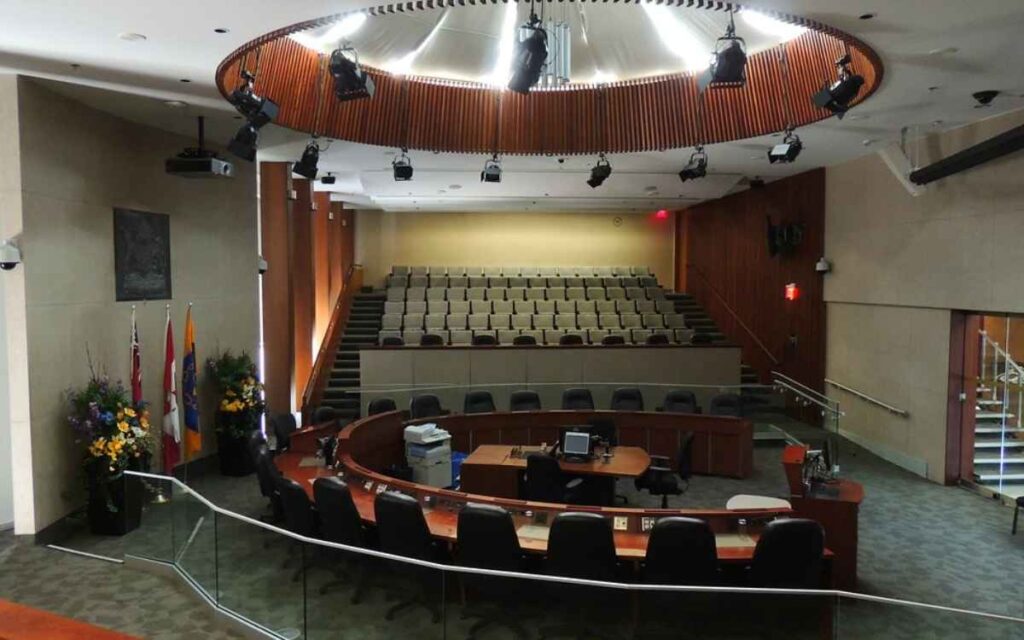
Hamilton is now coming up with a new Framework for Processing and Evaluating Urban Boundary Expansion Applications. Pictured: Hamilton City Hall Council Chambers. Photo Credit: Flickr.
Even though Hamilton City Council voted not to expand the municipality’s urban boundary in a 13-3 vote in November 2021, developers can still put forward individual applications for the land after legislative changes were recently made by the Ontario government.
The proposed urban boundary expansion involved opening up 2,200 hectares of land to development to help meet Hamilton’s housing targets.
That expansion involves “whitebelt” lands that are undeveloped but, unlike the Greenbelt, are not environmentally protected.
In November 2022, the province decided to open up the 2,200 hectares of land for housing, plus portions of the Greenbelt, but then reversed the decision after questions were raised surrounding the integrity of the government’s decision-making process.
What is not well known is that developers can still make individual applications to build on these whitebelt lands and the City of Hamilton is now coming up with a new Framework for Processing and Evaluating Urban Boundary Expansion Applications.
While there are 4,320 hectares of land within the City of Hamilton’s Rural Hamilton Official Plan, only about 2,200 hectares would be suitable for community uses such as housing, while another 2,120 hectares could “accommodate employment uses,” according to the city.
A draft of the framework, which is available on the City of Hamilton website, states, “While the City’s Official Plan does not support any urban boundary expansions outside of a city initiated Municipal Comprehensive Review or Official Plan review, the city also recognizes that under the proposed Provincial Planning Statement, 2024 and recent legislative changes made to the Planning Act through Bill 185, new privately initiated urban boundary expansion applications would be able to be received and approved at any time.”
The draft also reads that the purpose of the framework “is to ensure that any urban boundary expansion applications submitted are complete and comprehensively assess the implications of the proposal against municipal land use priorities.”
It continues, “This framework does not constitute a list of minimum submission requirements or criteria to determine whether an urban boundary expansion can receive municipal approval.”
Thus, the framework only provides suggestions to developers on how they can improve their application to the city, by answering questions such as how they will accommodate infrastructure needs, support transportation, and protect the natural environment.
The draft framework says that those wishing to expand Hamilton’s urban boundary should contact the Planning Division as early as possible to discuss their application, that the city “supports meaningful early engagement with Indigenous communities” before an application, and that the city “has established enhanced public notification requirements above and beyond what is required for a standard Official Plan Amendment.”
Once an application has been assessed by the city, the Planning Division will prepare a recommendation report for the Planning Committee and a final decision will be made.
However, under the Planning Act, a rejection by the city or a non-decision can still be appealed to the Ontario Land Tribunal within 120 days.
The city is continuing consultation on their draft plan, with consultation details available here.
The final draft of the framework will be submitted to Council in quarter one of 2025.
It remains to be seen how many developers will bring forward plans and if the City of Hamilton’s urban boundary will end up expanding after all.
One group that has been advocating for expansion to Hamilton’s urban boundary is The Elfrida Community Builders Group (Elfrida Group), made up of local residents, businesspeople, and homebuilders who own land in the Elfrida area of Hamilton.
The Elfrida area is located around the Upper Centennial Parkway and Regional Road 20 intersection.
They previously wrote a letter to Council that notes that, in 2006, nearly 20 years ago, the City of Hamilton identified the Elfrida Lands as the city’s “preferred growth area for needed housing.”
The Elfrida Group says that the November 2021 Land Needs Assessment, prepared by the city’s land needs consultant and the city’s chief planner and peer-reviewed by Watson and Associates Economists Ltd., “concluded that an urban boundary expansion of approximately 1,300 hectares was needed to accommodate growth to 2051” in Hamilton.
They add: “Both the chief planner and land needs consultant also concluded that the 1,300-hectare urban boundary expansion was needed in addition to, not as a substitute for the significant intensification targets recommended.”
Another association, the Upper West Side Landowners Group, has a plan for homes near Twenty Road West and Glancaster Road. Those plans have already been appealed to the Ontario Land Tribunal.

Based in Hamilton, he reaches hundreds of thousands of people monthly on Facebook, Instagram, TikTok, and Twitter. He has been published in The Hamilton Spectator, Stoney Creek News, and Bay Observer. He has also been a segment host with Cable 14 Hamilton. In 2017, he received the Chancellor Full Tuition Scholarship from the University of Ottawa (BA, 2022). He has also received the Governor General’s Academic Medal. He formerly worked in a non-partisan role on Parliament Hill in Ottawa.






